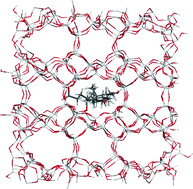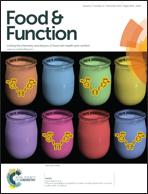Bile sequestration potential of an edible mineral (clinoptilolite) under simulated digestion of a high-fat meal: an in vitro investigation†
Abstract
Bile, important for cholesterol homeostasis, is a potential target of hypercholesterolemia management. Bile sequestration by orally administered resins, while mostly effective in reducing blood cholesterol, presents several side effects and disadvantages. Thus, widely available natural edible minerals such as clinoptilolite with adsorptive properties offer an alternative for bile sequestration. In an experimental setting mimicking the physiological conditions of digestion/absorption (pH, temperature, and retention times) with a series of assessment methods, scanning electron microscopy-energy dispersion X-ray analysis (SEM-EDX), X-ray diffraction (XRD), Fourier transform infrared analysis (FT-IR), thermogravimetric differential thermal analysis (TG-DTA), and molecular docking modeling, the ability of natural unmodified clinoptilolite to retain bile, while mixed with a simulated high-fat meal, was investigated. Our results demonstrate that clinoptilolite sequesters bile via adsorption of macromicelles at 75.4% efficiency, when the former is administered at a reasonable dose of 4% (w/w) of a meal's weight. This work provides the possibility of clinoptilolite utilization as a bile-sequestering/cholesterol-reducing agent.


 Please wait while we load your content...
Please wait while we load your content...